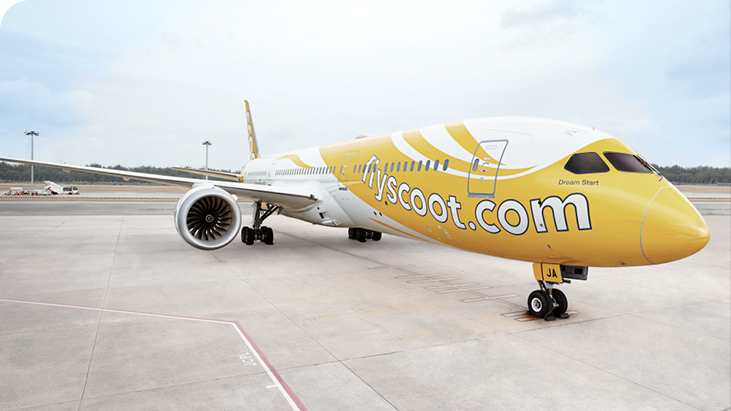The Tiger brand has never burned particularly brightly for Singapore Airlines and now it is about to be extinguished as the SIA Group brings low-cost subsidiary Tigerair under the bright yellow banner of the more successful Scoot.
The strategy to bring the two airlines under a single low-cost brand and operating licence is expected to be complete somewhere in the second half of next calendar year. It will include common flight scheduling as well as integrated website, contact centre and check-in counters.
The move comes after SIA completed a buyout of Tigerair earlier this year and in May put it and Scoot under the single umbrella of a new company, Budget Aviation Holdings.
BAH has a combined network of 59 destinations in 16 countries across the Asia-Pacific with Scoot operating fleet of 12 Boeing 787 Dreamliners and Tigerair offering short- to medium-haul flights on 23 Airbus A320 family aircraft.
“The integration has already led to commercial and operational synergies between Scoot and Tigerair that are providing growth opportunities for both airlines, an example being Scoot’s plan to launch its first European service, to Athens, next year,’’ said Singapore Airlines chief executive and Budget Aviation chairman Goh Choon Phong.
“Following a review we have determined that the logical next step is to pursue a common operating licence and common brand identity to enable a more seamless travel experience for customers.”
Budget Aviation Holdings Lee Lik Hsin said Tigerair’s established network and market presence in Southeast Asia would benefit from the strength of Scoot’s brand for the next phase of its growth. A single brand touchpoint would also enable a more seamless travel experience for passengers across the company’s network, he said.
SIA’s decision will not see the Tigerair brand disappear from the industry: it remains with Virgin Australia’s wholly-owned low-cost subsidiary in Australia and Tigerair Taiwan, a partnership between China Airlines, SIA and Mandarin Airlines.
Meanwhile, Singapore Airlines has joined a growing number of airlines warning that global politics and uncertainty remain a drag on their business.
The Singaporean carrier said in its half yearly profit announcement that the outlook for most major economies remained lukewarm .
“The passenger airline business continues to be impacted by geopolitical uncertainty and weak global economic conditions,’’ it said “The outlook in most major economies remains tepid.
“Furthermore, excess capacity and aggressive pricing continue to persist in the market, exerting pressure on loads and yields. with excess capacity and aggressive capacity continuing to exert pressure on loads and yields.’’
The Singaporeans also expressed concern about fuel price volatility, given uncertainty about the implementation of a proposed cut in OPEC oil production. Singapore has 29.3 per cent of it jet fuel requirement hedged at between $63 and $68 per barrel.
The International Air Transport Association has suggested there is a rebalancing of the oil market and analysts are expecting a weak upward trend. However, prices are tipped to remain relatively low at below $US60 per barrel until 2020.
Siingapore is one of number of airlines — including Qantas, Cathay Pacific and Virgin Australia — to express concern about the airline operating environment. The comments come as IATA has suggested the current profit cycle has peaked.
Singapore’s group revenue fell 3.6 per cent to $S7.3 billion in the first half with passenger revenue at the mainline “parent’’ carrier down 6.4 per cent due to downturn in yields.
The group reported a net profit of $322m for the half, up 5.6 per cent on last year, as lower fuel costs helped improve operating profits in its flying businesses and it benefited from a $S142m gain from the divestment of Hong Kong Aero Engine Services.
Parent carrier Singapore Airlines recorded a $S70m year-on-year increase in operating profit to $S276m, while Silkair was up $S18m to $S44m and budget offshoot Tigerair reversed last year’s $S10m loss to move $S11m into the black.
Long-haul low-cost carrier Scoot posted a $S6m first-half operating profit compared to a $S22m loss the previous year.
However, losses in cargo widened to $S45m and the profit at SIA Engineering fell from $48m to $23m.
The company is continuing to explore new routes, including inaugural flights to Dusseldorf and Canberra-Welling launched in recent months and the start of new non-stop daily A350-900 services to San-Francisco.
The group now serves 132 destinations across 36 countries, with the parent airline serving 61 destinations across 31 countries, including Singapore.
“The Group will remain nimble and flexible, leveraging its portfolio of airlines to cater to demand in different travel markets, while maintaining cost vigilance,’’ it said. “The improved operating capability and efficiency of the growing Airbus A350 fleet is enabling the launch of previously unserved new routes, while the deep integration between Scoot and Tiger Airways continues to provide cost efficiencies and opportunities to enhance network connectivity.’’
























